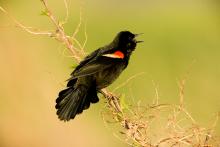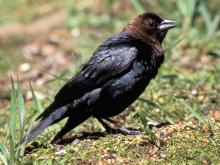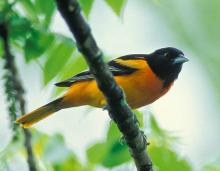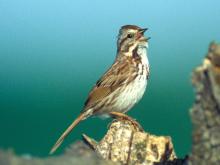Birds
Media

Species Types
Scientific Name
Bombycilla cedrorum
Description
Sleek, crested cedar waxwings gather in large, relatively quiet groups to eat berries from shrubs and trees. The voice is a high-pitched, whizzy trill.
Media

Species Types
Scientific Name
Vireo griseus
Description
The white-eyed vireo’s white irises would seem its most distinctive feature, but it’s actually better known for its distinctive, loud, vociferous song.
Media

Species Types
Scientific Name
Agelaius phoeniceus
Description
These crimson-shouldered residents of marshes, wet meadows and weedy roadside ditches are well-known by most rural Missourians. Their “konk-o-REEE” song likely emanates from every pond in Missouri.
Media

Species Types
Scientific Name
Euphagus carolinus
Description
Missourians most often see rusty blackbirds during spring and fall migration, though in southern Missouri they sometimes stay through the winter. Look for them foraging in pastures and fields near water.
Media

Species Types
Scientific Name
Molothrus ater
Description
The brown-headed cowbird never builds a nest of its own. Instead, it lays eggs, one at a time, in the nests of other birds. Each cowbird is raised by unwitting foster parents.
Media

Species Types
Scientific Name
Icterus galbula
Description
Often, you'll hear the male Baltimore oriole's loud, flutelike song before you locate the bright orange singer as he moves among the boughs of trees.
Media

Species Types
Scientific Name
Melospiza melodia
Description
The song sparrow is an uncommon nester but a common winter resident throughout Missouri. You can find the song sparrow along forest edges and in many backyards.
Media

Species Types
Scientific Name
Passerculus sandwichensis
Description
Savannah sparrows live in open habitat with nearby dense cover. In Missouri, we see them during migration and winters, but not summers.
Media

Species Types
Scientific Name
Zonotrichia albicollis
Description
White-throateds have a boldly striped black-and-white crown, gray cheek, and a yellow patch between the bill and the eye. They spend winter in Missouri.
Media

Species Types
Scientific Name
Setophaga castanea (formerly Dendroica castanea)
Description
The male bay-breasted warbler is easy to identify, while females and nonbreeding males present a challenge. This species migrates through Missouri in spring and fall.
See Also







Media

Species Types
Scientific Name
Hemaris diffinis
Description
The snowberry clearwing is a moth that confuses people because it looks like a bumblebee and flies like a hummingbird!
Media

Species Types
Scientific Name
Hyles lineata
Description
The white-lined sphinx moth sometimes confuses people because it flies, hovers, and eats from flowers like a hummingbird. The adults often fly during daylight hours as well as in the night and are often found at lights.
Media

Species Types
Scientific Name
Darapsa myron
Description
The Virginia creeper sphinx moth is common in woods and brushy areas and comes to lights at night. The larvae eat Virginia creeper and grape leaves.
Media

Species Types
Scientific Name
Perimyotis subflavus (formerly Pipistrellus subflavus)
Description
Tri-colored bats, formerly called eastern pipistrelles, are relatively small and look pale yellowish or pale reddish brown. The main hairs are dark gray at the base, broadly banded with yellowish brown, and tipped with dark brown.
Media

Species Types
Scientific Name
Myotis grisescens
Description
Gray myotises are difficult to distinguish from other mouse-eared bats. A key identifying feature of the gray myotis is that its wing is attached to the ankle and not at the base of the toes. It’s an endangered species.
Media

Species Types
Scientific Name
Myotis lucifugus
Description
The little brown myotis (little brown bat) is one of our most common bats, but populations are declining. White-nose syndrome has taken a heavy toll in northeastern states. This species is now listed as vulnerable across its range.
Media

Species Types
Scientific Name
Myotis sodalis
Description
The Indiana myotis, or Indiana bat, summers along streams and rivers in north Missouri, raising its young under the bark of certain trees. It is an endangered species.
About Birds in Missouri
About 350 species of birds are likely to be seen in Missouri, though nearly 400 have been recorded within our borders. Most people know a bird when they see one — it has feathers, wings, and a bill. Birds are warm-blooded, and most species can fly. Many migrate hundreds or thousands of miles. Birds lay hard-shelled eggs (often in a nest), and the parents care for the young. Many communicate with songs and calls.





















